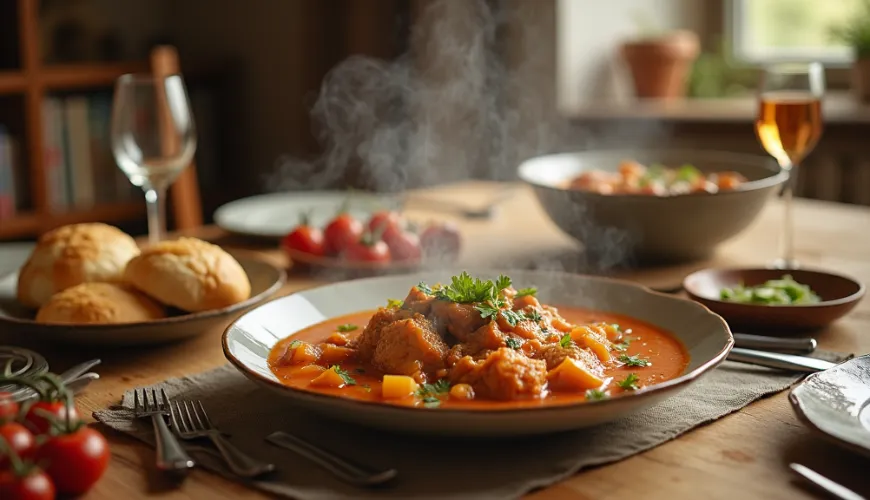
Try a great recipe for "katův šleha" to spice up your menu

Katův šleh - A Spicy Classic That Never Gets Old
Who doesn't know Katův šleh? A distinctive dish that has appeared on the menus of Czech pubs for decades, even though it's often neglected in home cooking. Yet, Katův šleh is the ideal recipe for days when there's no time to spend an hour at the stove, but the craving for something hearty and flavorful persists. This article not only looks at how to prepare the traditional version but also at a lesser-known, surprisingly tasty recipe for Katův šleh with lečo. And since it's a dish with history, we won't just view it as a mix of pork and ketchup but as a culinary imprint of a time when a little was made to go a long way.
What Exactly Is Katův šleh?
Although the name sounds dramatic, it certainly is not a historical recipe associated with executions. In reality, it's a simple meat mixture with a spicy sauce, earning its name from its bold flavor – sharp like the blow of an executioner's sword. The base is pork, onion, garlic, and a combination of tomato paste, ketchup, mustard, and hot paprika. The result is a filling dish that pairs well with fries, rice, or fresh bread.
This dish was particularly popular in workplace canteens and pubs during the 80s and 90s. Why? Low-cost ingredients, quick preparation, and a flavor that satisfies even hard-working individuals. Although there's often the opinion that it's "too ordinary" a dish, its simplicity is what makes it so beloved.
Traditional Recipe for Katův šleh
The foundation of a good Katův šleh is the right choice of meat. Most commonly, pork leg or shoulder is used - lean but juicy meat that cooks quickly and absorbs the flavor of the spices well.
Ingredients for 4 servings:
- 500 g of pork leg or shoulder
- 1 large onion
- 2 cloves of garlic
- 2 tablespoons of tomato paste
- 4 tablespoons of ketchup (ideally hot or homemade)
- 1 tablespoon of Dijon mustard
- 1 teaspoon of sweet paprika
- ½ teaspoon of hot paprika (or to taste)
- Salt, pepper
- Oil for frying
- A little water or broth for stewing
Cut the meat into thin strips – they should resemble "slashes" of a whip, perhaps the inspiration for the name. Fry finely chopped onion in oil, add the meat and sear it quickly so it browns. Once it releases its juices, add garlic, paprika, paste, mustard, and ketchup. Mix everything well and let it briefly sauté to meld the flavors. Then lightly add water or broth and simmer covered for about 15 minutes until the meat is tender.
The result is a thick, spicy mixture with a rich flavor, ideal for serving with a side dish but tasty on its own. Interestingly, Katův šleh is often compared to Hungarian pörkölt or Mexican chili con carne – although they are different dishes, they share a similar philosophy: a few basic ingredients, bold flavor, and a focus on practicality.
Katův šleh with Lečo
At first glance, it may sound unusual – why add a Hungarian-origin vegetable mix to a meat dish? But the combination of the sweet taste of lečo and the spicy sauce gives the dish a new dimension, which even those who find classic Katův šleh too heavy will love.
Lečo adds not only freshness but also texture and color. If you have homemade lečo from a summer harvest, all the better – fresh peppers and tomatoes are irreplaceable. Otherwise, a good-quality canned lečo without unnecessary preservatives will do.
The recipe for Katův šleh with lečo doesn't significantly differ from the classic method. Simply add about 200–300 g of lečo (depending on the desired consistency) to the prepared mixture and let it cook briefly. The resulting taste is milder but still distinctly spiced. Moreover, it becomes a great choice for those trying to include more vegetables in their diet, without giving up favorite flavors.
How to Customize Katův šleh to Your Taste
One of the greatest advantages of this recipe is its openness to modifications. Whether you decide to omit the hot paprika, replace ketchup with homemade tomato sauce, or add fresh chili, you'll always get a delicious dish. A vegetarian version can be prepared with tofu or modified seitan, ideally marinated to better absorb the spices. And if you're looking for a healthier alternative, opt for quality organic meat or even poultry – chicken strips cook even faster and are lighter.
One pub legend says that Katův šleh once originated as a "leftover dish" – a mix of what the chef had left from previous days. And precisely because of this, you can add practically anything you have at home to the base – from pickles to leftover beans or corn from the previous dinner.
Why Is Katův šleh Still Popular?
While many dishes from the past have faded into oblivion, Katův šleh has incredible staying power. Perhaps because it combines the comfort of home cooking with the boldness of spicy flavors, or perhaps because everyone can adapt it to their liking. Just like segedín or goulash, Katův šleh is a dish that isn't afraid of strong spices, yet remains understandable and accessible.
In one small village pub in South Bohemia, Katův šleh is served every Tuesday. According to the bartender, it's "the fastest dish on the menu that never has leftovers." They rely on the classic – no novelties, just a tried and true recipe that "even a person who hasn't had Katův šleh in 20 years would recognize." This emotional memory of flavors is what makes an ordinary dish something special.
And even though today's kitchens often lean towards exotic or vegetarian directions, there is room for traditional Czech dishes that haven't lost their significance. Perhaps it's time to rediscover Katův šleh – this time in home conditions and without preservatives, but with quality ingredients and a pinch of nostalgia.
"Food tastes best when there's a piece of memory in it," said the French chef Alain Ducasse once. And that might be the secret of Katův šleh – it's not just a mix of meat and spices, but the taste of a time when cooking was done with heart and with what was on hand.

